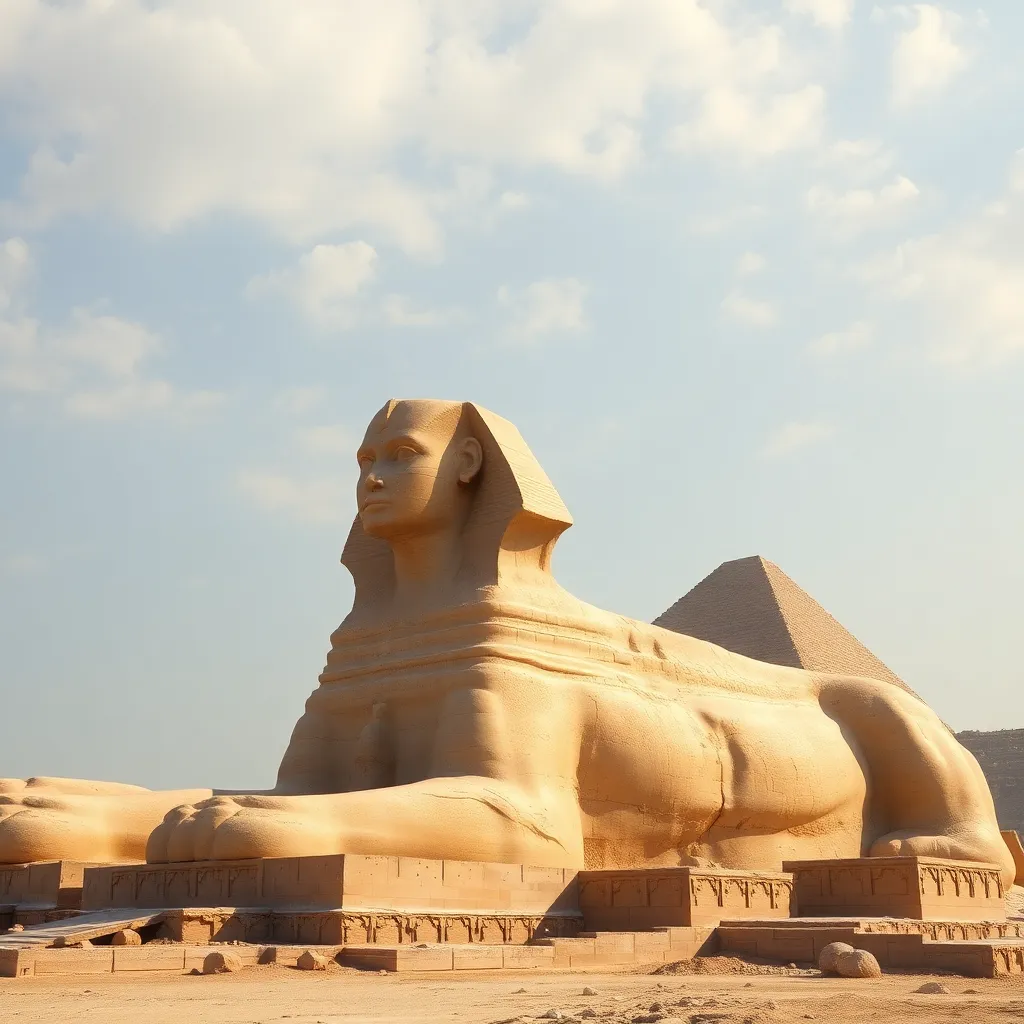The Sphinx: A Guardian of the Ancient Mysteries
I. Introduction
The Great Sphinx of Giza, an emblem of ancient Egyptian civilization, stands as a monumental guardian of the secrets of the past. This iconic figure, with the body of a lion and the head of a human, has long captured the imagination of historians, archaeologists, and tourists alike. In this article, we will delve into the rich history, symbolism, and ongoing mysteries surrounding the Sphinx, exploring its significance within the broader context of Egyptian mythology and culture.
II. Historical Context of the Sphinx
A. Origins and construction during the reign of Pharaoh Khafre
The Sphinx was constructed during the reign of Pharaoh Khafre, around 2500 BCE, and is believed to represent him. This colossal statue was carved from limestone and stands on the Giza Plateau, a site that also hosts the Great Pyramid of Giza, another of the Seven Wonders of the Ancient World. The Sphinx is thought to serve as a guardian to the tombs and temples located in this sacred area, reflecting the significance of the afterlife in ancient Egyptian belief.
B. The Sphinx in relation to the Giza Plateau and the Pyramids
Located adjacent to the Great Pyramid, the Sphinx is part of a larger complex of pyramids and mortuary temples that demonstrate the architectural advancement and religious fervor of ancient Egypt. Together, these structures form a unified landscape that was designed not only for the Pharaoh’s burial but also to honor the gods and the cosmos.
III. Architectural Marvel
A. Description of the Sphinx’s design and dimensions
The Sphinx is an architectural marvel, measuring approximately 73 meters (240 feet) long and 20 meters (66 feet) high. Its impressive dimensions make it one of the largest monolithic sculptures in the world. The face of the Sphinx is carved with remarkable precision, exhibiting features that some believe to resemble Pharaoh Khafre himself.
B. Materials used and techniques applied in its construction
The primary material used for the Sphinx was limestone, sourced from the Giza Plateau. Ancient builders employed simple yet effective tools to carve the statue, using chisels and hammers made from harder stones. The construction techniques reflect the advanced engineering skills of the ancient Egyptians, who were able to undertake such a colossal project with remarkable accuracy.
IV. Symbolism and Meaning
A. The Sphinx as a symbol of strength and protection
The Sphinx serves as a powerful symbol of strength and protection. In ancient Egyptian mythology, the lion was associated with the sun god Ra, representing power, courage, and guardianship. This connection highlights the Sphinx’s role as a protector of the Pharaohs and their journey to the afterlife.
B. Interpretation of the Sphinx’s human-animal hybrid form
The hybrid form of the Sphinx—combining human intellect with animal strength—embodies the duality of nature and the balance between human and divine qualities. This unique representation reflects the ancient Egyptians’ understanding of the cosmos and their belief in the interconnectedness of all beings.
V. Theories and Mysteries Surrounding the Sphinx
A. Theories about the Sphinx’s purpose and function in ancient society
The true purpose of the Sphinx remains a subject of debate among scholars. Some theories suggest it was built as a guardian for the pyramids, while others propose it served as a symbol of the Pharaoh’s divine right to rule. Additionally, the Sphinx may have been involved in ancient rituals and ceremonies, acting as a focal point for worship and offerings.
B. Speculations on the existence of hidden chambers and artifacts
Intriguingly, many researchers speculate about the existence of hidden chambers beneath the Sphinx. Some suggest that these chambers may contain artifacts or writings that could shed light on ancient Egyptian civilization. Various ground-penetrating radar studies have been conducted to uncover potential hidden spaces, fueling ongoing intrigue and speculation.
VI. Cultural Impact and Legacy
A. The Sphinx in ancient texts and mythology
The Sphinx has made appearances in various ancient texts and myths, often symbolizing mystery and enigma. In Greek mythology, the Sphinx is depicted as a creature that posed riddles to travelers, devouring those who could not answer correctly. This narrative has contributed to the Sphinx’s aura of mystery and has influenced its representation in art and literature throughout history.
B. Influence on art, literature, and modern interpretations
The imagery of the Sphinx has permeated art and literature across cultures and eras. From ancient sculptures to modern films and novels, the Sphinx continues to inspire creativity and fascination. Its enigmatic presence invites interpretation and has become a symbol of the timeless quest for knowledge and understanding.
VII. Preservation and Restoration Efforts
A. Challenges faced in the preservation of the Sphinx
Preserving the Sphinx poses significant challenges due to natural erosion, pollution, and the impact of tourism. Over the centuries, the statue has suffered from weathering and damage, necessitating ongoing preservation efforts to maintain its structural integrity and historical significance.
B. Recent restoration projects and archaeological findings
Recent restoration projects have aimed to address the deterioration of the Sphinx. Archaeologists have employed modern technologies to assess its condition and implement conservation strategies. Discoveries made during these projects have provided further insights into the construction and purpose of the Sphinx, enriching our understanding of this ancient wonder.
VIII. Conclusion
The Great Sphinx of Giza stands as a testament to the ingenuity and spirituality of ancient Egyptian civilization. Its enduring mystique and the mysteries surrounding its origins continue to captivate scholars and enthusiasts alike. As we explore the Sphinx’s historical context, architectural brilliance, and symbolic significance, we recognize its role as a guardian of ancient mysteries, forever inviting inquiry and admiration in modern times.




